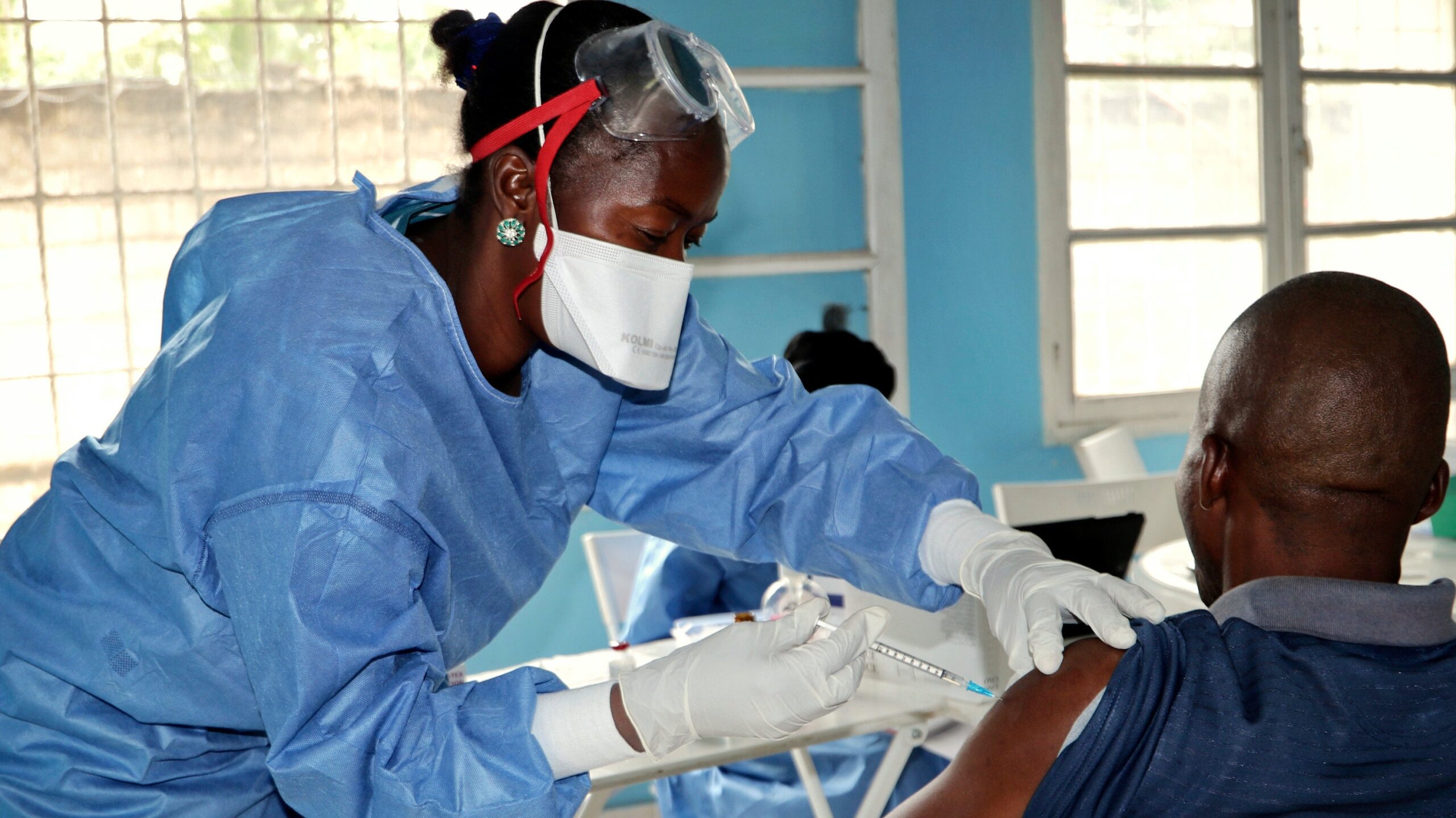BY MATTHEW GU
7. Modern day
EVD is classified as a biosafety level 4 agent, as well as a Category A
bioterrorism agent by the CDC as it has the potential to be weaponised for use
in biological warfare (Borio, 2002) and was investigated by Biopreparat for such use,
but might be difficult to prepare as a weapon of mass destruction because the virus
becomes ineffective quickly in open air (Zubray, 2013). North Korean state media
has suggested the disease was created by the U.S. military as a biological weapon
(BBC, 2015).
More recently, in March 2024, researchers at the University of Texas Medical Branch
reported promising results for Obeldesivir, an oral antiviral drug. Unlike treatments
requiring intravenous administration, Obeldesivir can be taken orally, making it more
accessible, especially in resource-limited settings. Studies in non-human primates
showed that once-daily oral administration provided complete protection against
lethal Ebola infection.
8. Conclusion
Ultimately, Ebola is no longer considered a global threat, and I hope this article
provides you no matter how little or how much, some insight into the virus and its
devastating effects. Significant progress has been made in tackling not just Ebola,
but all viruses and this is clearly illustrated in the 2019 COVID outbreaks globally.
Our determination and ability to work together as a planet to combat disease on the
brink of collapse is truly special and I hope this article reflects this.
9. Glossary
Antibodies: Proteins produced by the immune system to identify and neutralize
foreign substances like viruses and bacteria.
Antigens: Molecules or substances that trigger an immune response, often present
on the surface of pathogens.
Biopreparat: A Soviet-era biological weapons program, linked to the development of
infectious agents for warfare.
C-type lectins: Proteins that recognise carbohydrates on the surface of pathogens
and play a role in immune responses.
Dendritic cells: Specialised immune cells that capture pathogens and present
antigens to activate other immune cells.
DC-SIGN: A type of C-type lectin receptor found on dendritic cells, involved in
recognising viruses like Ebola.
Disseminated intravascular coagulation (DIC): A severe condition in which
widespread blood clotting occurs, leading to organ damage and bleeding.
Ecchymoses: Large, flat patches of bruising caused by bleeding under the skin.
Embalming: The process of preserving a body after death.
Endosomes: Membrane-bound compartments inside cells that transport materials,
including viruses, during infection.
Filamentous: A thread-like shape, describing the structure of the Ebola virus
particles.
Gastrointestinal haemorrhaging: Bleeding within the stomach or intestines, often
seen in severe Ebola cases.
Glycoprotein: A molecule made of proteins and sugars.
Haemorrhaging: Severe or uncontrolled bleeding.
Hematomas: Swellings caused by blood pooling outside blood vessels, often due to
trauma or bleeding disorders.
Hypodermic needles: Medical tool used for injections.
Integrins: Proteins on the surface of cells that help with cell adhesion and signalling.
Intravenous administration: Delivering medication or fluids directly into a vein
using a needle or catheter.
Lysosomes: Cell organelles that break down waste materials, including pathogens
engulfed during infection using hydrolytic enzymes.
Macrophages: Immune cells that engulf and destroy pathogens.
Maculopapular rash: A skin rash with both flat and raised red lesions, common in
Ebola infections.
Malaria: A mosquito-borne infectious disease caused by Plasmodium parasites,
often confused with early Ebola symptoms.
Megachiroptera: A suborder of large fruit bats, believed to be natural reservoirs for
the Ebola virus.
Monoclonal antibodies: Lab-produced antibodies designed to target specific
pathogens, used in Ebola treatment.
Mucous membranes: Moist linings of body cavities (e.g., mouth, nose) that can
serve as entry points for the Ebola virus.
Negative sense: Viral RNA genomes that must be converted into positive sense
RNA to make proteins.
Nucleoprotein: A protein that binds to and protects the viral RNA genome inside the
Ebola virus.
Petechiae: Tiny, pinpoint red or purple spots on the skin caused by bleeding under
the surface.
Platelet: A blood component responsible for clotting, often depleted in Ebola,
contributing to bleeding.
Positive-strand mRNAs: Messenger RNAs produced by the Ebola virus to direct
the host cell to make viral proteins.
Primates: Mammals like monkeys, apes, and humans.
Pro-inflammatory cytokines: Signalling molecules released by immune cells to
trigger inflammation, often overproduced in Ebola.
Progeny particles: New virus particles produced by infected cells during viral
replication.
Purpura: Purple or red spots on the skin caused by bleeding beneath the surface,
larger than petechiae.
RNA genome: The genetic material of the Ebola virus, made of ribonucleic acid
(RNA).
RNA polymerase: An enzyme that the Ebola virus uses to replicate its RNA genome
inside host cells.
Typhoid fever: A bacterial disease-causing fever and abdominal pain, often
misdiagnosed as Ebola in endemic areas.
Vascular leakage: A condition where blood vessels lose fluid, contributing to shock
and organ failure in Ebola.
Viral nucleocapsid: The protein shell that encases and protects the Ebola virus’s
RNA genome.
Zoonotic transmission: The spread of a disease from animals to humans, as seen
with Ebola.
10. Bibliography
Baize S, Pannetier D, Oestereich L, Rieger T, Koivogui L, Magassouba N, et al.
(October 2014). “Emergence of Zaire Ebola Virus Disease in Guinea” (PDF). New
England Journal of Medicine. 371 (15): 1418–1425.
Basler, C. F., Wang, X., Muhlberger, E., et al. (2003). The Ebola Virus VP35 Protein
Functions as a Type I IFN Antagonist. PNAS, 97(22), 12289–12294.
Bavari, S., Bosio, C. M., Wiegand, E., Ruthel, G., et al. (2002). Mechanisms of
Filovirus Cytopathology. Nature Reviews Microbiology, 3(7), 499–511.
Botelho G, Wilson J (8 October 2014). “Thomas Eric Duncan: First Ebola death in
U.S.” CNN. Archived from the original on 29 May 2016. Retrieved 8 August 2017.
Borio L, Inglesby T, Peters CJ, Schmaljohn AL, Hughes JM, Jahrling PB, et al. (May
2002). “Haemorrhagic fever viruses as biological weapons: medical and public health
management”. Journal of the American Medical Association. 287 (18): 2391–405.
Bray, M., & Geisbert, T. W. (2005). Ebola Virus: The Role of Macrophages and
Dendritic Cells in the Pathogenesis of Ebola Haemorrhagic Fever. International
Journal of Biochemistry & Cell Biology, 37(8), 1560–1566.
Carette, J. E., Raaben, M., Wong, A. C., et al. (2011). Ebola Virus Entry Requires the
Cholesterol Transporter NPC1. Nature, 477(7364), 340–343.
CDC (2019) Interim Guidance for Managing Exposure to Ebola Virus in Healthcare
and Public Health Settings. Available at: https://www.cdc.gov
Chan M (September 2014). “Ebola virus disease in West Africa – no early end to the
outbreak”. N Engl J Med. 371 (13): 1183–1185.
Chandran, K., Sullivan, N. J., Felbor, U., Whelan, S. P., & Cunningham, J. M. (2005).
Endosomal Proteolysis of the Ebola Virus Glycoprotein Is Necessary for Infection.
Science, 308(5728), 1643–1645.
Dixon MG, Schafer IJ (June 2014). “Ebola viral disease outbreak – West Africa,
2014″ (PDF). MMWR Morb. Mortal. Wkly. Rep. 63 (25): 548–551. PMC 5779383.
PMID 24964881. Archived (PDF) from the original on 23 October 2020. Retrieved 7
April 2020.
“Ebola gone from Guinea”. CBC News. Thomson Reuters. 29 December 2015.
Archived from the original on 30 December 2015. Retrieved 30 December 2015.
Feldmann, H., & Geisbert, T. W. (2011). Ebola Haemorrhagic Fever. The Lancet,
377(9768), 849–862.
Fernandez M (12 October 2014). “Texas Health Worker Tests Positive for Ebola”.
The New York Times. Archived from the original on 12 October 2014. Retrieved 12
October 2014.
Fairhead, J. (2016) Understanding Ebola: Social and Anthropological Perspectives.
Oxford: Routledge.
Goeijenbier M, van Kampen JJ, Reusken CB, Koopmans MP, van Gorp EC
(November 2014). “Ebola virus disease: a review on epidemiology, symptoms,
treatment and pathogenesis”. Neth J Med. 72 (9): 442–448
Hoenen T, Groseth A, Falzarano D, Feldmann H (May 2006). “Ebola virus:
unravelling pathogenesis to combat a deadly disease”. Trends in Molecular
Medicine. 12 (5): 206–215.
Henao-Restrepo, A. M., et al. (2017) ‘Efficacy and effectiveness of an rVSV-vectored
vaccine in preventing Ebola virus disease’, The Lancet, 389(10068), pp. 505–518.
King JW, Rafeek H (14 January 2021). Chandrasekar PH (ed.). “Ebola Virus, Clinical
Presentation”. Medscape.
Kortepeter MG, Bausch DG, Bray M (November 2011). “Basic clinical and laboratory
features of filoviral haemorrhagic fever”. J Infect Dis. 204 (Supplement 3): S810–16
Leroy, E. M., et al. (2004) ‘Multiple Ebola virus transmission events and rapid decline
of central African wildlife’, Science, 303(5656), pp. 387-390.
Leroy, E. M., et al. (2005) ‘Fruit bats as reservoirs of Ebola virus’, Nature, 438(7068),
pp. 575-576.
Magill A (2013). Hunter’s tropical medicine and emerging infectious diseases (9th
ed.). New York: Saunders. p. 332
Misasi J, Sullivan NJ (October 2014). “Camouflage and Misdirection: The Full-On
Assault of Ebola Virus Disease”. Cell. 159 (3): 477–486.
Modrow S, Falke D, Truyen U, Schätzl H (2013). “Viruses: Definition, Structure,
Classification”. In Modrow S, Falke D, Truyen U, Schätzl H (eds.). Molecular
Virology. Berlin, Heidelberg: Springer. pp. 17–30
Mühlberger, E. (2007). Filovirus Replication and Transcription. Future Virology, 2(2),
205–215.
“North Korea bans foreigners from Pyongyang marathon over Ebola”. BBC News
Online. 23 February 2015. Archived from the original on 24 February 2015.
Retrieved 23 February 2015.
Olejnik J, Ryabchikova E, Corley RB, Mühlberger E (August 2011). “Intracellular
events and cell fate in filovirus infection”. Viruses. 3 (8): 1501–31.
Preliminary study finds that Ebola virus fragments can persist in the semen of some
survivors for at least nine months”. Centres for Disease Control and Prevention
(CDC). 14 October 2015.
Regules, J. A., et al. (2015) ‘A recombinant vesicular stomatitis virus Ebola vaccine
— preliminary report’, New England Journal of Medicine, 373(13), pp. 1100–1108.
Sanchez, A., Geisbert, T. W., & Feldmann, H. (2006). Filoviridae: Marburg and Ebola
Viruses. In D. M. Knipe & P. M. Howley (Eds.), Fields Virology (5th ed., pp.
1409–1448). Lippincott Williams & Wilkins.
Shantha JG, Yeh S, Nguyen QD (November 2016). “Ebola virus disease and the
eye”. Current Opinion in Ophthalmology (Review). 27 (6): 538–544.
Singh SK, Ruzek D, eds. (2014). Viral haemorrhagic fevers. Boca Raton: CRC
Press, Taylor & Francis Group. p. 444
Subissi, L., et al. (2018) ‘Field evaluation of Ebola virus disease surveillance in
Liberia’, BMC Public Health, 18(1), pp. 1–10.
Tosh PK, Sampathkumar P (December 2014). “What Clinicians Should Know About
the 2014 Ebola Outbreak”. Mayo Clin Proc. 89 (12): 1710–17.
Wappes J. “US health worker monitored as DRC Ebola nears 600 cases”. CIDRAP.
Retrieved 23 January 2019.
WHO (2014) Ebola Virus Disease: Key Facts. Available at: https://www.who.int
WHO (2019) Ebola Vaccine Use in Emergencies. Available at: https://www.who.int
WHO (2020) Ebola Virus Disease: Democratic Republic of Congo. Available at:
https://www.who.int
Zubray G (2013). Agents of Bioterrorism: Pathogens and Their Weaponization. New
York: Columbia University Press. pp. 73–74. ISBN 978-0231518130. Archived from
the original on 4 May 2016.

